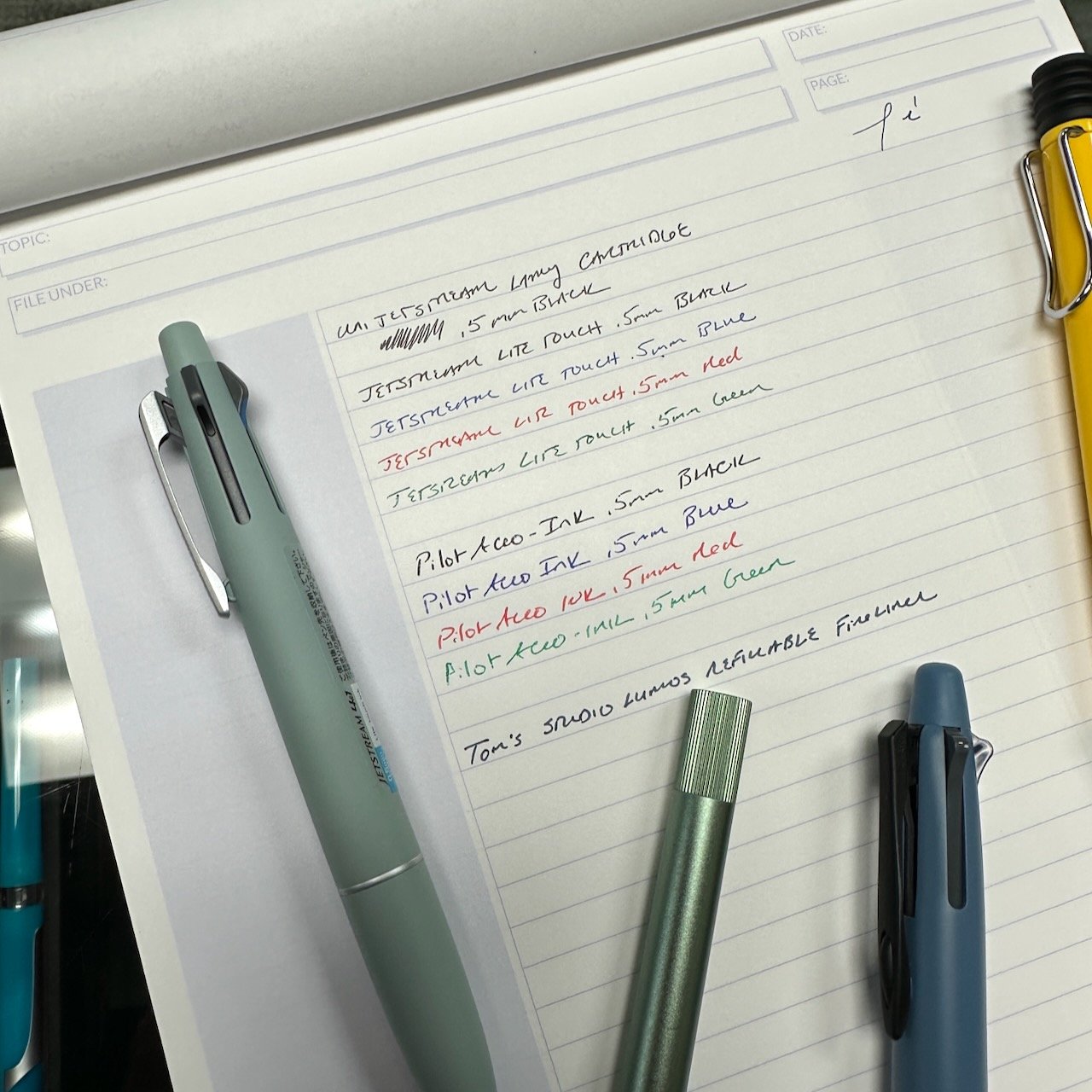I need to periodically address this topic because so many people come to me looking for recommendations for pens and ink that they can use on the thin, recycled paper that’s common around offices and schools. The bad news is that fountain pens are very difficult to use on “cheap” paper (i.e., the standard recycled copy paper your office buys in bulk), unless you want to invest in more expensive pigmented ink that requires more regular fountain pen maintenance. Your best bet, honestly, is to not use fountain pens under these circumstances unless you’re prepared to deal with some feathering and bleedthrough. Personally, I usually use a ballpoint pen (I prefer the newer low-viscosity versions), or a fine-tip gel pen. Here are five of my go-to recommendations.
Uni Jetstream. Why is the Jetstream No. 1 on this list? I recommend it because it’s universally available, with refills containing Jetstream ink now being made in pretty much every format. These will even fit non-Uni pens. In addition to availability, which is a huge plus, it’s permanent, comes in blue, black, and red ink options, and dries almost instantaneously, making it a good choice for lefties. Uni recently released the Jetstream “Lite Touch” ink formulation, which is slightly smoother, and may be preferable to those who prefer the feel of a gel pen over a ballpoint.
Pilot Acroball. I think I personally prefer the feel of Pilot’s “Acro-ink” to the Jetstream, but the fact that it’s not as widely available knocks it to number 2 on this list. It does, however, come in the same 4+1 multi pen format as the Jetstream, and if I had to spot a key difference, I would say that the Pilot Acroball pen writes a more solid line.
Platinum Carbon Black Ink. For those who abolutely have to use a fountain pen for everything, regardless of paper quality, you will have the best luck with pigmented ink. Platinum Carbon Black is the gold standard here (and if you want a really black ink, the more expensive Chou Kouro), but companies like Diamine and Tom’s Studio have their own versions which also work fairly well, as does Sailor. As noted above, pigmented ink can require more maintenance than standard water-based fountain pen ink, so be sure to periodically clean your pens to prevent any clogging.
Gel Pens .5mm or finer. While gel pens are definitely better than rollerballs and fountain pens on bad paper, they’re not oil-based like ballpoints so they can still feather and bleed in the larger tip sizes. Finer sizes (.5mm, .38mm, etc.) should do better.
Fineliners. If you enjoy writing with a pen that doesn’t require you to use a lot of pressure, fineliners can be an excellent alternative to fountain pens because the finer tip sizes don’t put as much ink on the page and therefore might not feather or bleed. Tom’s Studio makes a couple of different refillable fineliners that allow you to use your fountain pen inks, and pigmented fineliners like the famed Sakura Pigma Micron also work quite well. I’m a huge proponent of fine-tip fineliners at work.
For those who wish to buy their own office-grade paper (“office grade” in the sense that it’s inexpensive), the Midori Spiral Note Basic Notebook averages around $6-8 and can be a very cost-effective option if you burn through a lot of paper regularly. I’ve actually had a few customers inquire about making this a standard for their office, which I love to hear!
I write a lot about this subject, but low-quality paper is a growing problem as workplaces try to cut the cost of paper (or eliminate it entirely). The other day I came across a legal pad where the paper quality was so poor that the ink they used to print the lines on the pad had feathered. (Yes, they sent that product to market, and yes, some company paid for it.) As you might expect, the only thing that worked remotely well on such poor paper was a ballpoint or a pencil. If you find yourself having to work through similar situations regularly, hopefully you find this post helpful. Your options may be limited, but you do have options!
I write a series of posts under the “Ask TGS” tag, where I try to respond to the most frequently asked questions from readers and in-store customers. I’ve compiled the most frequent inquiries into a stand-alone FAQ resource, which is periodically updated
